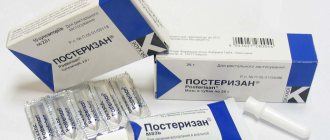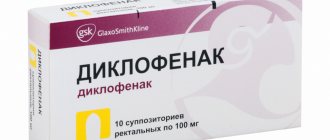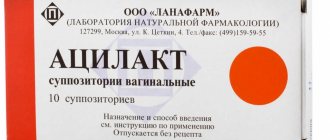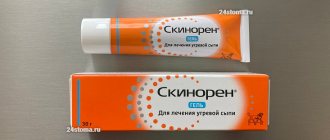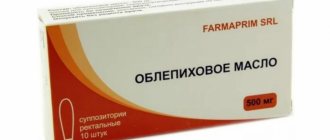A whole line of medicines is produced under the name “Hepatrombin”. To treat hemorrhoids, Hepatrombin G is used, which is available in the form of ointments and suppositories for rectal administration. The drugs can be used simultaneously: treat external manifestations of varicose veins of the rectum and anus with ointment, and insert suppositories into the rectum.
Compound
The ointment contains the main substances: sodium heparin, prednisolone acetate and lauromacrogol 600 .
Additional components: solid and liquid paraffin, silicon dioxide, lanolin .
Rectal suppositories include the following active ingredients: sodium heparin, prednisolone acetate and lauromacrogol 600.
Additional components: medium chain triglycerides, solid fat, colloidal silicon dioxide, glyceryl tristearate.
Operating principle
Gepatrombin ointment. 20 g
The main active components of the ointment are sodium heparin, dexpanthenol and allantoin. Thanks to this composition, Heparin exhibits antithrombotic, regenerative, anticoagulant, anti-edematous and anti-inflammatory activity.
Sodium heparin is a glycosaminoglycan produced by mast cells, which are found in all tissues of the body. Its highest concentration is observed in the lungs, intestines and liver. For medical use, it is obtained from the organs of cattle. It is a direct acting anticoagulant.
The mechanism of its action is to inhibit the activity of thrombin, which entails a slowdown in blood clotting and inhibition of thrombus formation. This component also helps reduce swelling and inflammation in the walls of blood vessels and improve local blood circulation.
In addition, it improves the flushing and removal of stagnant tissue fluid and harmful metabolic end products. Upon direct contact with the skin and mucous membranes, it quickly penetrates the subcutaneous tissue and small blood vessels, where it begins to act.
It is excreted slowly from tissues; its excretion period is about 1 hour.
Allantoin is an astringent and keratolytic agent that has a regenerating and anti-inflammatory effect. Promotes the separation of dead cells and stimulates tissue regeneration. Dexpanthenol has a stimulating effect on the regeneration of mucous membranes and skin, accelerates the division of eukaryotic cells, increases the density of collagen fibers and normalizes metabolism at the cellular level.
When applied externally, it penetrates well into the skin and systemic bloodstream, where it is converted into panthenolic acid and takes part in the processes of acetylation, lipid and carbohydrate metabolism, the formation of corticosteroids, porphyrins and acetylcholine. Allantoin and dexpanthenol enhance the effect of heparin, ensuring its better penetration into tissues and local blood flow.
Pharmacodynamics and pharmacokinetics
This combined drug is actively used in proctology, exhibiting antithrombotic, anti-inflammatory and venosclerotic effects.
Its main component, heparin , is a well-known direct-acting anticoagulant. It is also characterized by increasing the ability to regenerate connective tissue and preventing blood in the area of hemorrhoids.
As for prednisolone , which belongs to GCS, it exhibits anti-inflammatory, antiexudative and antiallergic effects, reducing itching and burning sensations, pain in the anorectal area.
Lauromacrogol 400 or polidocanol has a local anesthetic effect, providing sclerosis in the area of hemorrhoids .
Penetrating into the body, Hepatrombin G ointment, like suppositories, undergoes biotransformation in the liver and reticuloendothelial system. Plasma protein binding can reach at least 95%. The drug is excreted through the kidneys in several stages.
How does Gepatrombin G work?
The drug is used in proctology to eliminate the main signs of exacerbation of hemorrhoids: irritation, swelling, pain, itching and burning. The effectiveness of the medicine is based on the components it contains:
- heparin reduces platelet activity, prevents the formation of blood clots in hemorrhoids, stimulates the regeneration of connective tissue, and promotes the healing of damage;
- prednisolone reduces inflammation, helps eliminate swelling, prevents the accumulation of exudate in the affected area, reduces pain and itching;
- lauromacrogol quickly relieves the burning sensation and helps in the regeneration of damaged epithelium.
The effect of the drug develops quickly. Within 10–15 minutes after application, acute pain and burning subsides. There is a pleasant feeling of coolness. On the first day of use, false urges to defecate and itching disappear. As treatment continues, swelling and unpleasant symptoms in the anorectal area decrease and then gradually disappear. At the same time, the risk of blood clots in the venous nodes is reduced, and they themselves decrease in size.
The components of Gepatrombin G are partially absorbed through the mucous membranes into the bloodstream. Their concentration in the body is insignificant to lead to systemic changes or health problems. The remains of the drug are transformed in the liver tissues, then excreted throughout the day through the kidneys.
Contraindications
This drug in any form is not prescribed for:
- bacterial, viral and fungal skin lesions;
- tuberculosis;
- syphilis;
- skin tumors;
- reactions to vaccination;
- early pregnancy ;
- predisposition to bleeding;
- sensitivity to the drug.
Instructions for Gepatrombin G (Method and dosage)
Gepatrombin G ointment instructions for use recommend applying a thin layer to the affected areas until the symptoms of the disease disappear and some more time to consolidate the result. During the main therapy, the ointment can be applied 3 times a day, and then 1 time throughout the week.
The ointment can also be used rectally - inserted into the rectum using the tip, lightly pressing on the tube and squeezing out a little of the drug.
Gepatrombin G suppositories instructions for use recommend administering rectally 1-2 times a day, preferably after defecation.
When is it prohibited to use Gepatrombin G?
It is necessary to refuse therapy with suppositories and ointments:
- with reduced blood clotting, bleeding from the anus;
- oncological benign and malignant intestinal tumors;
- with infectious lesions of the rectum, the presence of parasites;
- for tuberculosis, syphilis;
- fungal, bacterial lesions of the skin and mucous membranes;
- in case of individual intolerance to the components of the drug.
Signs of a possible allergic reaction to Hepatrombin G: increased itching and severe burning a few hours after administration of the drug, sensation of a foreign object in the rectum, increased dryness of the mucous membrane.
Analogs
Level 4 ATC code matches:
Girudoproct
Heparoid Zentiva
Heparin ointment
Heparin
Lyoton
Trombless
Venolife
Hepatrombin
The main analogues of this drug: Proctosedyl, Proctosan and Girudoproct.
Reviews of Gepatrombin G
It should be noted that reviews of Gepatrombin G ointment are mainly related to the treatment of hemorrhoids. Usually the drug is used for the resorption of hemorrhoidal cones . This therapy turns out to be very effective and helps to quickly get rid of unwanted symptoms.
You can also find reviews about Hepatrombin G suppositories, but this form of the drug is used by patients somewhat less frequently, although it is no less effective.
In addition, reviews of Gepatrombin G ointment for hemorrhoids report that sometimes it is not used entirely for its intended purpose. For example, this external remedy can be used to resolve hematomas that form after injections. There are cases when the ointment was used by women to eliminate swelling and bags under the eyes.
In addition to reports of the effectiveness of this drug, one can find stories about the development of side effects during improvement. Usually these are allergic reactions in the form of itching, rashes and swelling.
Despite the fact that this drug helps well in some off-label cases, it should not be used on its own. This is especially true during pregnancy, when any treatment requires maximum caution.
For what diseases is Hepatrombin G prescribed?
Suppositories are prescribed for external and internal localization of hemorrhoids, as well as in the treatment of:
- inflammatory process in the veins of the anus and rectum with the formation of blood clots;
- defects and wounds of the anal mucosa - cracks and fistulas.
Proctologists recommend Hepatrombin G at the preparatory stage for surgery on the rectum or anus, in the complex therapy of hemorrhoidal thrombosis, and when monitoring hemorrhoids after surgery.
Gepotrombin suppositories are a powerful drug, therefore they are used in the treatment of advanced hemorrhoids, as well as those complicated by thrombosis of the rectal veins.
Price Gepatrombin G, where to buy
The price of Gepatrombin G in suppositories varies between 220-300 rubles.
You can buy ointment for 180-250 rubles.
The price of Gepatrombin G ointment in Ukraine starts from 50 UAH.
- Online pharmacies in RussiaRussia
- Online pharmacies in UkraineUkraine
ZdravCity
- Gepatrombin G rectal suppositories.
10 pcs. Hemofarm A.D. Vršac, branch Production site Šabac 324 RUR.order - Gepatrombin G ointment 20g Hemofarm A.D. Vršac, branch Production site Šabac
RUB 323 order
Pharmacy Dialogue
- Hepatrombin G suppositories (sup. rect. No. 10) Hemofarm
RUB 319 order
- Gepatrombin G ointment 20g Hemofarm
320 rub. order
- Hepatrombin gel (tube 50000 units 40 g)Hemofarm
RUB 259 order
show more
Therapeutic aspects of hemorrhoid treatment
For many decades, hemorrhoids have been and remain a pressing medical problem. This is due to the widespread prevalence of the disease - hemorrhoids and its complications are the cause of 40% of visits to a surgeon or proctologist, a significant decrease in the quality of life of such patients, and an increase in the total number of days of disability.
The first scientific definition of hemorrhoids was given in the 18th century, when cavernous plexuses were discovered, formed during normal embryogenesis in the submucosal layer of the distal part of the rectum. However, only in the middle of the last century did foreign and domestic scientists establish that hemorrhoids are the result of impaired hemodynamics and an inflammatory process in the vessels of the hemorrhoidal plexuses, which is accompanied by thrombosis, varicose veins, as well as sclerosis of the veins and is often complicated by bleeding.
Etiology and classification of hemorrhoids
Despite the fact that a significant number of studies have been devoted to the problem of hemorrhoids, the etiology of this disease is still not fully understood. Currently, great importance is attached to hereditary factors, in particular genetically mediated incompetence of vascular connective tissue and mesenchyme in general [5, 6].
Factors contributing to the appearance and development of hemorrhoids are:
- constipation, which occurs in more than 75% of patients;
- venous circulation disorders in the lower half of the body, developing with prolonged standing, sedentary lifestyle, obesity, bronchial asthma;
- dysfunction of the rectum, causing spasm of the internal sphincter (psycho-emotional disorders, adhesive disease);
- disruption of portosystemic blood flow due to alcohol abuse, fatty foods, and the use of certain medications;
- chronic inflammatory diseases of the anorectal zone and pelvic organs (bacterial salpingoophoritis, prostatitis, cystitis), leading to inflammation of vascular formations, hemodynamic disturbances and lymphogenous spread of infection into the hemorrhoidal plexuses;
- pregnancy.
Depending on the location of hemorrhoids, internal hemorrhoids are distinguished, in which the nodes are located inward from the dentate line of the anal canal, and external, with the nodes located distal to it. A combined form of the disease is often encountered.
The course of hemorrhoids can be acute or chronic. There are four degrees of severity of hemorrhoids:
I degree - swollen, sometimes bleeding, captive hemorrhoids; II degree - prolapsed nodes are reduced independently; III degree - prolapsed hemorrhoids can be reset only by manual manipulation or instrumentally; IV degree - prolapsed hemorrhoids cannot be reduced.
Typical locations for hemorrhoids are the left lateral, right anterior and right posterior walls of the anal canal.
Clinical picture and diagnosis
Hemorrhoids affect people of any age, and men and city residents who lead a sedentary lifestyle are more likely to suffer from hemorrhoids.
The clinical picture of hemorrhoids is characterized by a triad of symptoms, including pain, bulging of hemorrhoids due to thrombosis and inflammation in the node itself and surrounding tissues, as well as bleeding.
Pain during bowel movements and emptying the rectum is most often associated with thrombosis of the internal hemorrhoid or anal fissure. Discharge from the anal canal in acute hemorrhoids is a consequence of the inflammatory process and is a mucous or inflammatory substance. They can cause a feeling of wetness, which leads to anal itching and scratching of the skin of the perianal area.
Bleeding from hemorrhoids usually occurs after or during a bowel movement and rarely leads to significant blood loss and anemia. It should be remembered that the symptoms of colon diseases are quite monotonous and bleeding can be a sign not only of hemorrhoids, but also of malignant neoplasms, polyps, ulcerative colitis and Crohn's disease [4]. In case of bleeding associated with damage to the perianal area, the released blood (in the form of traces on toilet paper or drops falling on the walls of the toilet) is usually not mixed with feces, which in such cases retains its inherent brown color. If the source of bleeding is located proximal to the rectosigmoid colon, then the blood is more or less evenly mixed with the stool, so that it is usually not possible to identify its normal color.
To make a correct diagnosis, it is imperative to carry out not only an examination of the perianal area, but also a digital examination of the rectum and anoscopy or sigmoidoscopy to a level of 15-60 cm above the anus. At the slightest suspicion of a neoplasm and detection of multiple polyps in the colon, a colonoscopy or irrigoscopy is performed.
Thus, the diagnostic criteria for hemorrhoid decompensation are [1, 8]:
- anorectal bleeding;
- characteristic pain syndrome;
- bulging hemorrhoids;
- unusual rectal discharge;
- swelling and pathological sensations in the perianal area;
- dissatisfaction with the act of defecation.
Treatment
The main methods of treating hemorrhoids today are [1, 2, 3]:
- radical hemorrhoidectomy (open, closed, closed circular stapler, submucosal);
- minimally invasive treatment methods (ligation of nodes with rubber strips, sclerotherapy, direct current electrocoagulation, coagulation with infrared rays, cryotherapy);
- conservative treatment.
When choosing a tactic and method of treating hemorrhoids, it is necessary to take into account the location and severity of the disease, the presence of complications, the severity of pain, the severity of the patient’s general condition and the degree of his disability, as well as the patient’s plans for treatment.
Currently, according to most literature sources, conservative therapy, which is justified in 20-45% of cases, is an effective and appropriate method of treating hemorrhoids [5]. A clear confirmation of this is the fact that the number of surgical hemorrhoidectomies in the United States decreased from 165,000 in 1982 to 30,000 in 1994 [6, 7].
Indications for conservative treatment are mild and moderate hemorrhoids, severe hemorrhoids of any location that occur during pregnancy, as well as the impossibility of surgical treatment for other reasons.
The most important conditions for successful treatment and prevention of subsequent exacerbations of the disease are normalization of the digestive tract, regulation of the consistency of intestinal contents and its transit through the colon. For this purpose, a diet rich in plant fiber is prescribed along with regular and sufficient consumption of water and osmotically active nutrients, such as fruit and vegetable juices. As a source of dietary fiber, or, as they are also called, hydrophilic colloids, in our country wheat bran, seaweed and flaxseed are traditionally used in their natural form or in the form of pharmacological preparations. Abroad, psyllium seeds and husks and flaxseed are more often used, which form the basis of such drugs as agiolax, fiberlax, nutriclinz, which have a high water-holding capacity. In the system of treatment and preventive measures, a significant role is given to the correction of emotional disorders, cessation of smoking and consumption of alcohol, drugs, coffee, and increasing the physical activity of patients.
Pharmacotherapy as the main component of conservative treatment of hemorrhoids has several goals:
- pain relief;
- elimination of the inflammatory process;
- elimination of hemorrhoidal thrombosis;
- relaxation of the internal sphincter of the rectum;
- normalization of microcirculation in the affected area.
Just a few years ago, the arsenal of drugs available to help achieve these goals was minimal, limiting choice. Nowadays, the abundance of remedies used for hemorrhoids, on the contrary, has given rise to the opposite problem: which one to choose in each specific case. To do this, it is necessary to know the mechanisms of action of drugs and those aspects of pathogenesis that they should influence.
Planned conservative therapy includes:
- painkillers;
- thrombolytic agents;
- antibacterial therapy;
- laxatives;
- physiotherapy;
- drugs that help stop straining during bowel movements.
Drug therapy for hemorrhoids can be local (ointments, creams, gels, rectal suppositories) or general (systemic).
To eliminate pain, combined painkillers in the form of gels, ointments and suppositories are used. The most widely used drugs are aurobin, ultraproct, and procto-glivenol. It should be noted the effectiveness of new painkillers - nefluan and emla, which are characterized by high concentrations of lidocaine and neomycin. The use of a short course of systemic non-narcotic analgesics is justified only for severe and complicated hemorrhoids. Prescribing narcotic analgesics is not advisable, since these drugs significantly increase the tone of the internal sphincter of the rectum and make defecation difficult.
Anti-inflammatory therapy is based on the use of fast-acting glucocorticoids, in particular prednisolone. For hemorrhoids, preference should be given to local treatment, since it does not interfere with tissue repair, is accompanied by minimal resorption and a low risk of systemic action of glucocorticoids. However, local treatment is contraindicated for viral, fungal and other specific lesions of the rectum and anorectal area. In these cases, nonsteroidal anti-inflammatory drugs with a combined effect (ketoprofen, diclofenac, indomethacin) are used.
Thrombosis of hemorrhoidal vessels, especially complicated by their inflammation, is an indication for the use of combination drugs containing analgesic, thrombolytic and anti-inflammatory components. This group of drugs includes proctosedyl, procto-glivenol, hepatrombin G, produced in the form of ointments, gels and suppositories. The preference for prescribing the latter drug is explained by the fact that it contains the three most active components of the pathogenetic treatment of hemorrhoids: heparin, polidocanol and prednisolone. Heparin, by binding plasma coagulation factors and having an inhibitory effect on hemostasis, has a thrombolytic effect; polidocanol provides an analgesic effect; prednisolone is anti-inflammatory. In addition, the drug contains panthenol, which stimulates metabolic processes, granulation and epithelization of tissues. Rectal suppositories Gepatrombin G are administered into the rectum after bowel movements 1-3 times a day. Gepatrombin G ointment is advisable to use for external hemorrhoids. The course of treatment with hepatrombin G is 1-2 weeks. The advantages of the drug are the extremely rare development of side effects and the possibility of use during pregnancy due to the minimal systemic effect. According to G.I. Vorobyov, rapid subsidence of pain was noted in 87% of patients who underwent treatment; reduction of thrombosis and inflammatory processes - in 91% of patients [2].
Local anticoagulants are widely used in the treatment of hemorrhoids. In addition to the above-mentioned hepatrombin G, this group of drugs includes heparin and troxevasin ointment, nigepan. Medicines containing heparin are the drugs of choice for acute thrombosis of hemorrhoids, but they are quite effective for any form of hemorrhoids. When prescribing locally acting heparin-containing drugs, complete resorption of thrombotic masses occurs no earlier than 4-8 weeks from the start of therapy, which must be taken into account when developing treatment tactics. A relative contraindication to local treatment with heparin is disorders of the blood coagulation system.
In 70-80% of cases, the inflammatory process spreads to the subcutaneous tissue and perianal area. In these cases, drugs containing heparin are used in combination with water-soluble ointments that have a powerful anti-inflammatory effect, such as levosin, levomekol, mafenide.
The basis of hemorrhoid therapy is the use of phlebotropic drugs that increase the tone of the veins, improve microcirculation in the cavernous bodies and normalize blood flow in them. This problem can be solved with the help of drugs such as escin, tribenoside, troxerutin, as well as new generation drugs: detralex, cyclo-tri-forte, ginkor-forte, endothelon.
According to most experts, the most effective drug in this group is Detralex. Its use leads to relief of pain in 83% of cases, reduction of prolapse of nodes in 81% of cases, and reduction of bleeding in 91% of cases. In the group of patients taking Detralex, there was a 2-fold reduction in the frequency of use and a 2-fold reduction in the dosage of non-narcotic analgesics, a 2.2-fold reduction in the incidence of annual exacerbations, a 2-fold reduction in the duration of exacerbations, and a 1.5-fold reduction in the overall average severity of exacerbations [2 ].
For intestinal bleeding, a laxative diet, taking a 10% solution of calcium chloride orally, and introducing suppositories with novocaine, belladonna extract and epinephrine into the rectum are indicated. You can use suppositories containing adrenaline. In addition, local hemostatic materials such as adroxon, beriplast, tachycomb, spongostan, consisting of fibrinogen and thrombin, are used. When introduced into the anal canal, they dissolve, forming a fibrin film that blocks the bleeding areas of the hemorrhoids.
An important role in the conservative treatment of hemorrhoids is given to drugs that reduce straining and cause easier bowel movements. For this purpose, laxatives with emollient and osmotic effects are prescribed: psyllium, lactulose and macrogol. To relax the internal sphincter of the rectum, ointments and creams containing nitroglycerin, isosorbide dinitrate, nifedipine, as well as suppositories containing belladonna extract are used [1, 4, 6].
Local anti-inflammatory and fibrinolytic treatment, as well as regulation of the tone of the internal sphincter of the rectum, as well as measures aimed at facilitating defecation, do not lose their relevance even after surgical treatment, since they not only contribute to the rapid rehabilitation of the patient, but also prevent the development of scars and dystrophic diseases skin of the anorectal area, strictures, fissures and rectal incompetence.
Literature
- Vovk E.I. Rational pharmacotherapy is a factor in the successful treatment of hemorrhoids // Breast Cancer. 2002. T.10. No. 2. pp. 73-77.
- Vorobyov G.I., Shelygin Yu.A., Blagodarny L.A. Conservative therapy of acute hemorrhoids // Consilium medicum. Application. 2001. pp. 32-34.
- Datsenko B. M., Druzhinin E. B., Protsenko A. G. Hemorrhoids: principles of treatment and diagnosis // Kharkov Med. magazine. 1995. No. 3-4. pp. 43-46.
- Rivkin V.L., Kapuller L.L., Dultsev Yu.V. Hemorrhoids and other diseases of the anal canal // M.: Medicine, 1994. 143 p.
- Brisinda G. // BMJ 2000. Sep. 9; 321 (7261). R. 582-583.
- Bruch HP, Roblick UJ // Chirurg. 2001. Jun; 72(6). R. 656-659.
- Metcalf A. Anorectal disorders. Five common causes of pain, pain and bleeding // Postgraduate Medicine Univ. Jova Hospital and Clinic. 1995. R. 221-228.
- Otto P., Otto J., Kisbi K. Haemorrhoids: a clinical update // Med. J. Austria, 1997. 167. R. 85-88.
Note!
- Hemorrhoids and their complications are the cause of 40% of visits to a surgeon or proctologist, as well as a significant decrease in the quality of life of patients.
- Hemorrhoids affect people of any age, and men and city residents who lead a sedentary lifestyle are more likely to suffer from hemorrhoids. The clinical picture of hemorrhoids is characterized by a triad of symptoms, including pain, bulging of hemorrhoids due to thrombosis and inflammation in the node itself and surrounding tissues, as well as bleeding.
- Indications for conservative treatment are mild and moderate forms of hemorrhoids, as well as severe hemorrhoids of any location that occur during pregnancy, or the impossibility of surgical treatment of hemorrhoids for other reasons.
- When choosing a tactic and method of treating hemorrhoids, it is necessary to take into account the location and severity of the disease, the presence of complications, the severity of pain, the severity of the patient’s general condition and the degree of his disability, as well as the patient’s plans for treatment.
